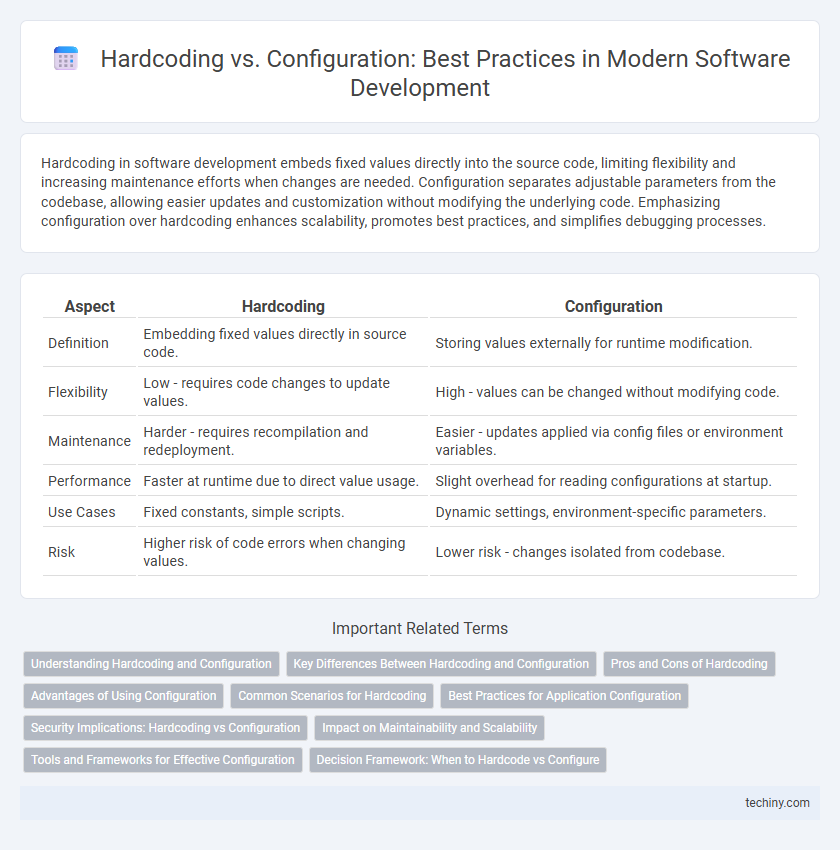Hardcoding in software development embeds fixed values directly into the source code, limiting flexibility and increasing maintenance efforts when changes are needed. Configuration separates adjustable parameters from the codebase, allowing easier updates and customization without modifying the underlying code. Emphasizing configuration over hardcoding enhances scalability, promotes best practices, and simplifies debugging processes.
Table of Comparison
| Aspect | Hardcoding | Configuration |
|---|---|---|
| Definition | Embedding fixed values directly in source code. | Storing values externally for runtime modification. |
| Flexibility | Low - requires code changes to update values. | High - values can be changed without modifying code. |
| Maintenance | Harder - requires recompilation and redeployment. | Easier - updates applied via config files or environment variables. |
| Performance | Faster at runtime due to direct value usage. | Slight overhead for reading configurations at startup. |
| Use Cases | Fixed constants, simple scripts. | Dynamic settings, environment-specific parameters. |
| Risk | Higher risk of code errors when changing values. | Lower risk - changes isolated from codebase. |
Understanding Hardcoding and Configuration
Hardcoding involves embedding fixed values directly into the source code, which simplifies initial development but reduces flexibility and maintainability. Configuration externalizes these values, allowing dynamic modifications without altering the codebase, enhancing adaptability across different environments. Understanding the trade-offs between hardcoding and configuration is essential for scalable software design and efficient deployment management.
Key Differences Between Hardcoding and Configuration
Hardcoding involves embedding fixed values and logic directly into the source code, making changes slow and error-prone as updates require code modification and redeployment. Configuration externalizes settings and parameters, allowing dynamic adjustments without altering the core codebase, which enhances flexibility and simplifies maintenance. Key differences include adaptability, with configuration supporting environment-specific variations and hardcoding limiting scalability and increasing risks during updates.
Pros and Cons of Hardcoding
Hardcoding in software development ensures faster performance and simplicity by embedding fixed values directly into the code, reducing runtime dependencies. However, it limits flexibility and scalability, as changes require code modifications and redeployment, increasing maintenance costs. Hardcoded values also pose risks for adaptability in diverse environments, making configuration files or environments variables a more sustainable choice for dynamic applications.
Advantages of Using Configuration
Using configuration instead of hardcoding enhances software flexibility by allowing changes without modifying the source code, which reduces deployment time and the risk of introducing bugs. Configuration management supports scalability and easier maintenance, enabling teams to adapt the application to different environments and requirements quickly. This approach also promotes better security by isolating sensitive data from the codebase, facilitating safer updates and compliance management.
Common Scenarios for Hardcoding
Hardcoding is commonly used for fixed values that rarely change, such as API endpoints in internal tools or default settings in early-stage prototypes. It simplifies initial development by embedding constants directly into the code, reducing the need for external dependencies or configuration files. This approach is practical in scenarios where performance and stability outweigh flexibility, especially in tightly controlled environments.
Best Practices for Application Configuration
Hardcoding application settings reduces flexibility by embedding values directly into the source code, complicating updates and environment-specific adjustments. Utilizing external configuration files or environment variables enables dynamic reconfiguration without redeploying the application, enhancing maintainability and scalability. Best practices recommend separating configuration from code, securing sensitive data through encrypted storage, and applying version control to configuration artifacts for traceability and consistency.
Security Implications: Hardcoding vs Configuration
Hardcoding sensitive information such as API keys and passwords directly into source code poses significant security risks, including unauthorized access and difficulties in managing secrets. Configuration management enables secure storage and dynamic retrieval of credentials through environment variables or dedicated secrets management tools, minimizing exposure and facilitating updates without code changes. Employing configuration practices adheres to the principle of least privilege and supports compliance with security standards like OWASP and GDPR.
Impact on Maintainability and Scalability
Hardcoding values in software development reduces maintainability by making updates and bug fixes more time-consuming and error-prone, as changes require modifying source code directly. Configuration files or environment variables enhance scalability by allowing dynamic adjustments without code changes, facilitating easier adaptation to different environments or user requirements. Employing configurable designs supports modularity and improves long-term system flexibility, critical for evolving applications and growing user bases.
Tools and Frameworks for Effective Configuration
Tools and frameworks like Spring Boot, Docker, and Ansible streamline configuration management by externalizing settings from code, enhancing flexibility and scalability. Using environment variables, YAML or JSON configuration files, and centralized configuration servers supports dynamic adjustment without redeployment. These practices minimize risks associated with hardcoding values, improve maintainability, and enable seamless integration across diverse environments in software development.
Decision Framework: When to Hardcode vs Configure
Choosing between hardcoding and configuration depends on factors like frequency of changes, scalability, and maintenance effort. Hardcoding suits fixed values that rarely change and require minimal overhead, while configuration supports dynamic settings, enabling flexibility and ease of updates without code modifications. Evaluating project requirements, deployment environments, and update cycles guides the optimal decision framework for managing application parameters.
Hardcoding vs Configuration Infographic

 techiny.com
techiny.com